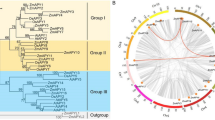Abstract
In mammals, yeast and Drosophila, the histone deacetylase RPD3 proteins can alter the expression of genes involved in fundamental biological processes by affecting the degree of acetylation of histones and changing chromatin structure. Here we report the isolation of a cDNA sequence encoding an RPD3 homologue from maize, which is able to complement the phenotype of an rpd3 null mutant of the yeast Saccharomyces cerevisiae. The expression of the corresponding gene(s) was assessed in different maize tissues. The number of homologous loci was estimated by Southern hybridisation to be in the range of two to three, and the chromosomal location of one of these loci was determined. Phylogenetic analysis and tests for relative divergence rates, using related RPD3 sequences from different species, were performed, and suggest that different polymorphic forms of RPD3-like proteins that evolve at distinct rates are present in the species considered.
Similar content being viewed by others
Author information
Authors and Affiliations
Additional information
Received: 5 December 1997 / Accepted: 16 January 1998
Rights and permissions
About this article
Cite this article
Rossi, V., Hartings, H. & Motto, M. Identification and characterisation of an RPD3 homologue from maize (Zea mays L.) that is able to complement an rpd3 null mutant of Saccharomycescerevisiae . Mol Gen Genet 258, 288–296 (1998). https://doi.org/10.1007/s004380050733
Issue Date:
DOI: https://doi.org/10.1007/s004380050733




